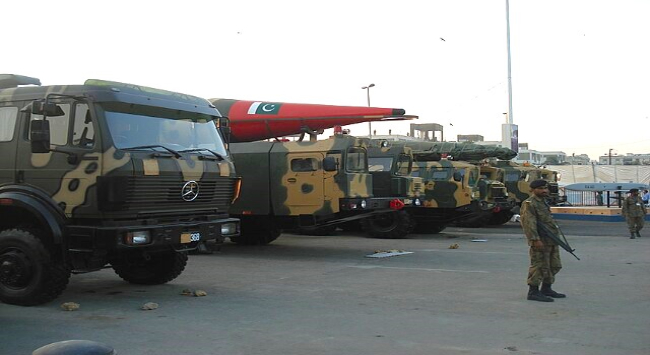Summary
Although Pakistan views its nuclear and missile programme as primarily directed against India, its implications are wider and has drawn sanctions from the United States. The growing reach of these missiles as well as the danger of their proliferation seem to have nudged the Joe Biden Administration into imposing new measures against the growing sophistication of Pakistan’s missile arsenal and its potential impact on the volatile Middle East region.
On 18 December 2024, the United States (US) Department of State announced in a fact sheet that under Executive Order 13382, targeting proliferators of weapons of mass destruction (WMD) and their delivery systems, the US was imposing sanctions on four Pakistani entities: the Pakistani government-owned National Development Complex (NDC) located in Fatehjung near Islamabad, and three private companies – Akhtar and Sons Pvt Ltd (Karachi), Affiliates International (Karachi) and Dockside Enterprises (Karachi). The three private companies were identified as having assisted the NDC in procuring materials for Pakistan’s long-range ballistic missile programme.
The NDC, established in 1995, has acquired a critical role in the subsequent years, as it became central to Pakistan’s development of solid-fuel ballistic missiles with Chinese assistance. Before the NDC’s establishment, China and Pakistan had faced US sanctions under the Missile Technology Control Regime (MTCR) for transferring M-11 ballistic missiles. The two countries attempted to circumvent the MTCR restrictions through technology transfer from China to Pakistan, aiming to present the missiles as indigenous Pakistani developments.
The NDC’s last US sanctions came in 1998 when the Bill Clinton administration imposed restrictions under the Arms Export Control Act and Export Administration Regulations for unspecified nuclear or missile activities. President George W Bush waived these sanctions in 2001 to enable post-September 11 counter-terrorism collaboration with Pakistan.
Over the past two and a half decades, the NDC has reportedly acquired Chinese technology and expertise to develop various solid-fuel ballistic and cruise missiles. It is particularly known for producing the Shaheen series of solid-fuel, medium and intermediate-range ballistic missiles – Shaheen 1, 2 and 3. While Shaheen 1 is a single-stage ballistic missile, Shaheen 2 and 3 feature two stages, demonstrating Pakistan’s mastery of staging technology with Chinese assistance. Chinese engineers are reported to regularly visit the NDC and facilitate the transfer of critical items and subsystems to Pakistan.
Today, the NDC is believed to be largely self-sufficient in solid-fuel ballistic missile technology. It has imported and stockpiled precursor chemicals for manufacturing hydroxy terminated polybutadiene – the solid fuel used in these missiles – along with missile casings and critical components, including aluminum powder and hydrazine from China.
Pakistan still requires international assistance for guidance systems and re-entry technology. The NDC has reportedly recruited private entities to acquire these technologies from the Western black and gray markets. Regarding the impact of the sanctions, given the NDC’s heavy reliance on China, their effect on Pakistan’s missile and WMD development programme will likely be minimal. Historical sanctions have only strengthened China-Pakistan cooperation and led to new ways of circumventing technology control regimes.
The US clearly understands this China-Pakistan relationship, which raises the question: Why impose sanctions now? One possible explanation is Pakistan’s mastery of staging technology with the Shaheen 3 intermediate-range ballistic missile (IRBM), positioning it to develop longer-range systems. Islamabad has tried to ease Western concerns by claiming its longer-range systems target Indian territories such as the Andaman Islands.
The US’ concerns were recently voiced by senior White House official Jon Finer at the Carnegie Endowment for International Peace. Finer warned that Pakistan’s continued advancement in long-range ballistic missile systems and technologies “will have the capability to strike targets well beyond South Asia, including the United States, raising real concerns about Pakistan’s intentions.”
Pakistan is advancing toward nuclear-capable ballistic missiles that could strike targets in the Middle East, including US military facilities and Israel. The distance from Quetta to Tel Aviv is 3,900 kilometres (km), and with the Shaheen III range of 2,750 km, Pakistan is steadily approaching this capability. The US is particularly concerned about Pakistan’s development of multiple independently targetable reentry vehicle (MIRV) capability.
The Ababeel IRBM, which Pakistan claims is MIRV-capable and designed to penetrate India’s ballistic missile defence, would have similar capabilities westward – a troubling prospect for both Israel and the US. Pakistan’s proliferation record raises additional concerns. Washington recognises that Iran’s current nuclear threshold status stems from technology transferred by the Pakistani proliferation network, led by A Q Khan, including centrifuges and nuclear weapons design.
The Iranian missile strike against Israel in October 2024, while causing minimal damage, demonstrated that some missiles penetrated Israel’s Iron Dome and struck airfields and critical infrastructure. Iranian missiles primarily derive from modified Scud and North Korean liquid-fueled Nodong missiles. However, Iran is now transitioning to solid-fuel systems based on technology similar to Pakistan’s Shaheen, with Chinese assistance. The sanctions against the NDC and its affiliated companies reflect renewed American concerns about missile threats and potential nuclear and missile proliferation from Pakistan.
In the past, Washington previously downplayed Pakistan’s proliferation network due to the US’ counter-terrorism priorities and Pakistan’s strategic role in Afghanistan. These constraints no longer seem to apply since the US withdrew its forces from Afghanistan in 2021. As US and Israeli concerns about Iran’s nuclear threshold status grow, punitive measures against countries and entities that enabled Iran’s progress may increase in coming years.
. . . . .
Professor C Raja Mohan is a Visiting Research Professor at the Institute of South Asian Studies (ISAS), an autonomous research institute at the National University of Singapore (NUS). He can be contacted at crmohan@nus.edu.sg. The author bears full responsibility for the facts cited and opinions expressed in this paper.
Picture credit: https://commons.wikimedia.org/w/index.php?search=pakistan+ballistic+missiles&title=Special:MediaSearch&go=Go&type=image
-
 More From :
More From :
-
 Tags :
Tags :
-
 Download PDF
Download PDF


